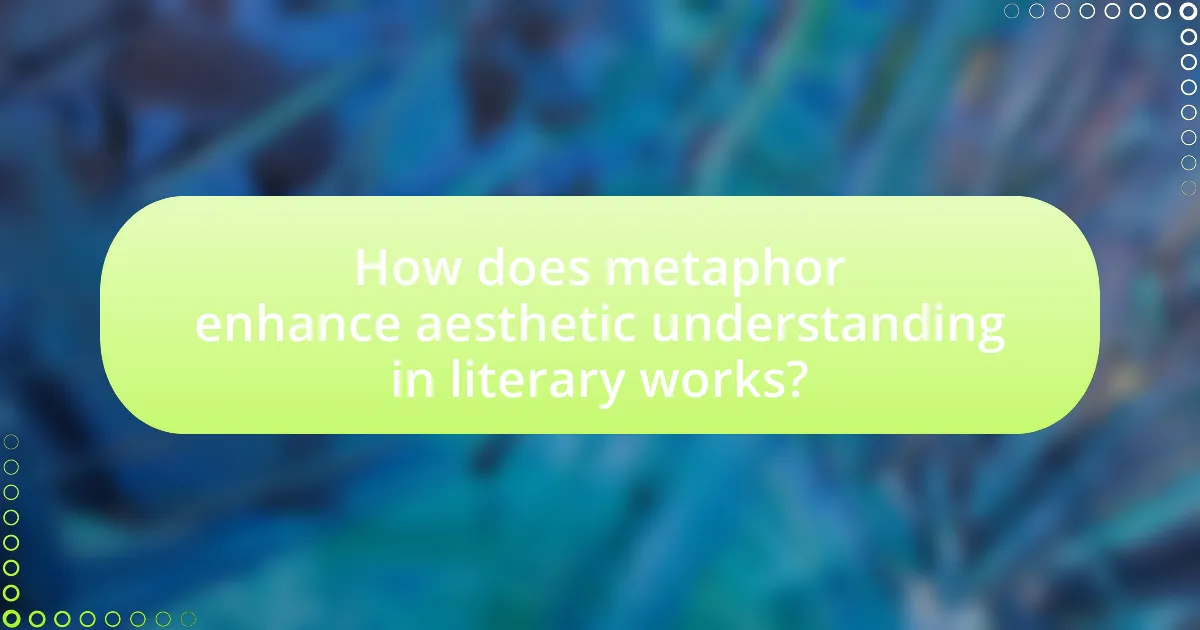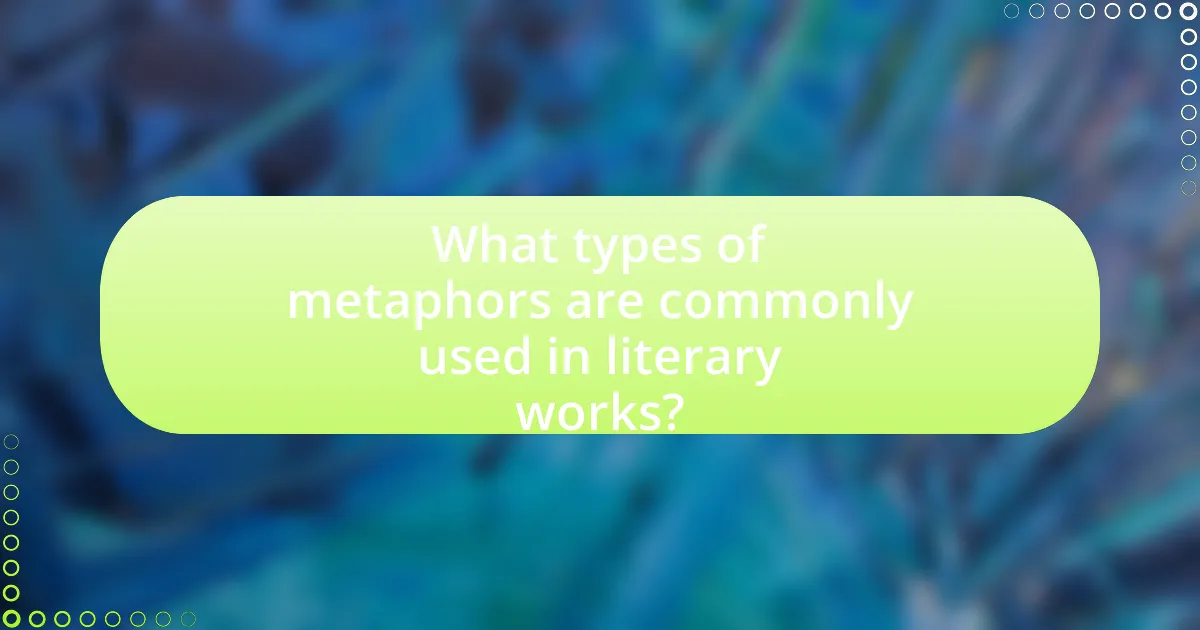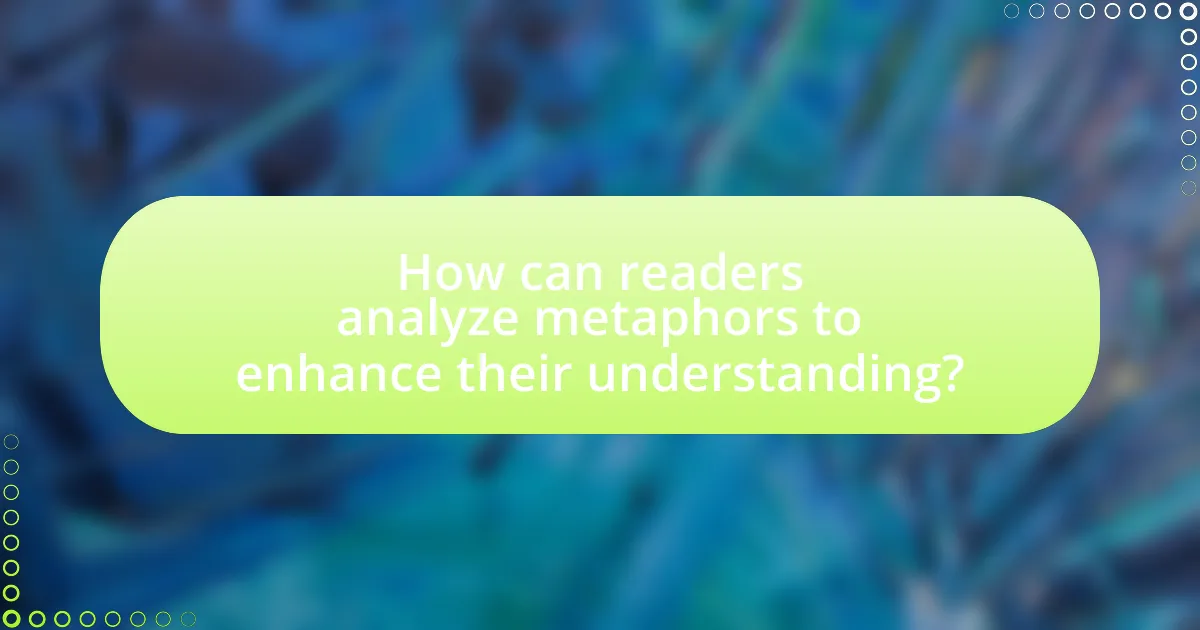Metaphor plays a vital role in enhancing aesthetic understanding in literary works by creating vivid imagery and emotional connections that deepen reader engagement. This article explores how metaphors convey complex ideas succinctly, allowing for multi-layered interpretations of themes and emotions. It examines the various types of metaphors, their impact on literary meaning, and the importance of aesthetic understanding in literary analysis. Additionally, the article discusses strategies for interpreting metaphors and the challenges posed by cultural differences and misconceptions, ultimately highlighting the significance of metaphor in enriching the reader’s experience and comprehension of literature.

How does metaphor enhance aesthetic understanding in literary works?
Metaphor enhances aesthetic understanding in literary works by creating vivid imagery and emotional resonance that deepens the reader’s engagement with the text. Through the use of metaphor, authors can convey complex ideas and emotions succinctly, allowing readers to draw connections between disparate concepts. For example, in Shakespeare’s “Juliet is the sun,” the metaphor not only illustrates Juliet’s brightness and warmth but also evokes feelings of love and longing, enriching the reader’s experience. This technique fosters a multi-layered interpretation of the text, enabling readers to explore themes and emotions that might remain unarticulated without such figurative language.
What role does metaphor play in literature?
Metaphor plays a crucial role in literature by enabling deeper emotional and conceptual connections between ideas and experiences. It allows authors to convey complex themes and emotions succinctly, enhancing the reader’s understanding and engagement with the text. For instance, in Shakespeare’s works, metaphors such as “All the world’s a stage” illustrate the transient nature of life, prompting readers to reflect on their own existence. This use of metaphor not only enriches the narrative but also invites multiple interpretations, fostering a more profound aesthetic experience.
How do metaphors create vivid imagery in texts?
Metaphors create vivid imagery in texts by comparing one thing to another, allowing readers to visualize concepts in a more relatable and impactful way. This figurative language evokes sensory experiences and emotions, enhancing the reader’s understanding and engagement with the text. For example, when Shakespeare describes a character’s anger as “a boiling pot,” it conjures a clear image of intensity and potential overflow, making the emotion more tangible. Research indicates that metaphors activate specific neural pathways associated with sensory experiences, further illustrating their effectiveness in creating vivid imagery.
What emotional responses do metaphors evoke in readers?
Metaphors evoke a range of emotional responses in readers, including empathy, nostalgia, and inspiration. These emotional reactions occur because metaphors create vivid imagery and connections that resonate with personal experiences. For instance, when a metaphor likens life to a journey, it can evoke feelings of nostalgia as readers reflect on their own life experiences. Research by Lakoff and Johnson in “Metaphors We Live By” illustrates that metaphors shape our understanding and emotional responses by framing concepts in relatable terms. This framing can intensify emotional engagement, making the literary work more impactful.
Why is aesthetic understanding important in literary analysis?
Aesthetic understanding is important in literary analysis because it allows readers to appreciate the emotional and sensory experiences conveyed through a text. This understanding enhances the interpretation of themes, character development, and stylistic choices, leading to a deeper engagement with the work. For instance, studies have shown that readers who focus on aesthetic elements, such as imagery and metaphor, can better grasp the underlying meanings and emotional resonance of literary pieces, as highlighted in research by Paul Ricoeur in “The Rule of Metaphor.” This connection between aesthetic appreciation and literary analysis underscores the significance of engaging with a text on an emotional level to fully comprehend its artistic value.
How does aesthetic understanding influence reader interpretation?
Aesthetic understanding significantly influences reader interpretation by shaping how individuals perceive and engage with literary texts. This understanding allows readers to appreciate the emotional and sensory dimensions of a work, leading to deeper connections with the themes and characters. For instance, research by Paul Ricoeur in “The Rule of Metaphor” highlights that metaphors enrich the aesthetic experience by enabling readers to draw parallels between the text and their own experiences, thus enhancing interpretative depth. Consequently, readers with a strong aesthetic understanding are more likely to uncover nuanced meanings and emotional resonances within the narrative, leading to a more profound interpretation of the literary work.
What are the key components of aesthetic understanding in literature?
The key components of aesthetic understanding in literature include emotional resonance, sensory engagement, and thematic depth. Emotional resonance allows readers to connect personally with characters and situations, enhancing their overall experience. Sensory engagement involves the use of vivid imagery and descriptive language that stimulates the senses, making the text more immersive. Thematic depth refers to the exploration of complex ideas and moral questions, prompting readers to reflect on broader human experiences. These components work together to create a rich literary experience that deepens appreciation and understanding of the text.

What types of metaphors are commonly used in literary works?
Common types of metaphors used in literary works include direct metaphors, implied metaphors, extended metaphors, and mixed metaphors. Direct metaphors explicitly state that one thing is another, such as “Time is a thief,” while implied metaphors suggest a comparison without directly stating it, like “He sailed through life.” Extended metaphors develop a comparison over several lines or throughout an entire work, enhancing thematic depth, as seen in Shakespeare’s “All the world’s a stage.” Mixed metaphors combine elements from different metaphors, often leading to humorous or confusing effects, such as “We’ll burn that bridge when we get to it.” These types of metaphors enrich the text, allowing for deeper emotional resonance and layered meanings.
How do different types of metaphors affect literary meaning?
Different types of metaphors significantly affect literary meaning by shaping the reader’s interpretation and emotional response. For instance, conceptual metaphors, which frame abstract ideas in terms of more concrete experiences, can deepen understanding by linking complex themes to familiar contexts. An example is the metaphor “time is money,” which influences how readers perceive the value of time in relation to productivity and urgency. Additionally, similes and extended metaphors enrich imagery and create layers of meaning, as seen in Shakespeare’s use of “all the world’s a stage,” which invites readers to reflect on life as a performance. These varied metaphorical forms enhance the aesthetic experience by engaging readers’ imaginations and prompting critical thought about the text’s themes and messages.
What is the difference between similes and metaphors?
Similes and metaphors are both figures of speech used to make comparisons, but they differ in their structure. A simile explicitly compares two different things using the words “like” or “as,” such as “as brave as a lion,” while a metaphor makes an implicit comparison by stating that one thing is another, such as “time is a thief.” This distinction is significant in literary works, as similes often create vivid imagery and clarity, while metaphors can convey deeper meanings and emotional resonance.
How do extended metaphors deepen thematic exploration?
Extended metaphors deepen thematic exploration by allowing complex ideas to be conveyed through sustained comparisons, which enrich the reader’s understanding of the underlying themes. For instance, in literature, an extended metaphor can connect disparate elements, such as comparing life to a journey, thereby illustrating themes of growth, struggle, and discovery over time. This technique encourages readers to engage with the text on multiple levels, as they interpret the layers of meaning embedded within the metaphor. The effectiveness of extended metaphors is evidenced in works like John Bunyan’s “The Pilgrim’s Progress,” where the journey metaphor encapsulates the spiritual quest, thereby enhancing the thematic depth of the narrative.
What are some examples of effective metaphors in literature?
Effective metaphors in literature include “All the world’s a stage” from William Shakespeare’s “As You Like It,” which compares life to a theatrical performance, emphasizing the roles people play. Another example is “Hope is the thing with feathers” by Emily Dickinson, where hope is likened to a bird, suggesting its lightness and resilience. Additionally, in F. Scott Fitzgerald’s “The Great Gatsby,” the green light symbolizes Gatsby’s unattainable dreams, illustrating the theme of aspiration. These metaphors enhance the reader’s understanding by providing vivid imagery and deeper emotional resonance.
How do classic literary works utilize metaphor for aesthetic effect?
Classic literary works utilize metaphor to create vivid imagery and evoke emotional responses, enhancing the reader’s aesthetic experience. For instance, in Shakespeare’s “Romeo and Juliet,” the metaphor of light and darkness illustrates the intensity of love and the tragedy of fate, allowing readers to grasp complex emotions through relatable imagery. Similarly, in Emily Dickinson’s poetry, metaphors such as “Hope is the thing with feathers” encapsulate abstract concepts in tangible forms, making them accessible and resonant. These examples demonstrate how metaphors serve as powerful tools for deepening understanding and appreciation of themes, ultimately enriching the aesthetic quality of the literature.
What contemporary examples illustrate the power of metaphor?
Contemporary examples illustrating the power of metaphor include the use of “the melting pot” to describe American society, which conveys the idea of diverse cultures blending together. This metaphor effectively communicates the complexity of cultural integration and identity in the United States. Another example is the phrase “time is a thief,” which encapsulates the notion that time can stealthily take away moments from our lives, emphasizing the urgency of cherishing experiences. These metaphors enhance understanding by providing vivid imagery that resonates emotionally with audiences, making abstract concepts more relatable and impactful.

How can readers analyze metaphors to enhance their understanding?
Readers can analyze metaphors by identifying the underlying concepts they represent and examining their contextual significance within the text. This process involves recognizing the figurative language used, understanding the relationships between the metaphorical elements, and interpreting the emotional or thematic implications they convey. For instance, in literature, metaphors often encapsulate complex ideas or emotions, allowing readers to gain deeper insights into characters’ motivations or the narrative’s themes. By dissecting these comparisons, readers can uncover layers of meaning that enhance their overall comprehension of the work.
What strategies can be used to interpret metaphors in texts?
To interpret metaphors in texts, one effective strategy is to analyze the context in which the metaphor is used, as this provides insight into its intended meaning. Context includes the surrounding text, the author’s background, and the cultural or historical setting, which can all influence how a metaphor is understood. For example, in literature, a metaphor comparing love to a journey may reflect the complexities of relationships, depending on the characters’ experiences and the narrative’s tone. Additionally, identifying the literal meanings of the components of the metaphor can help clarify its figurative implications. Research by Lakoff and Johnson in “Metaphors We Live By” illustrates that metaphors shape our understanding of abstract concepts through concrete experiences, reinforcing the importance of context and literal interpretation in metaphor analysis.
How does context influence the interpretation of a metaphor?
Context significantly influences the interpretation of a metaphor by providing the necessary background and situational cues that shape its meaning. For instance, in literature, the cultural, historical, and emotional context surrounding a text can alter how a metaphor is perceived; a metaphor that evokes a sense of loss in one cultural setting may convey resilience in another. Research by Lakoff and Johnson in “Metaphors We Live By” illustrates that metaphors are not merely linguistic expressions but are rooted in our conceptual frameworks, which are heavily influenced by context. Thus, understanding the specific circumstances in which a metaphor is used is crucial for accurate interpretation.
What questions should readers ask when encountering a metaphor?
Readers should ask the following questions when encountering a metaphor: What is being compared, and what is the significance of this comparison? Understanding the elements involved in the metaphor helps clarify its meaning and purpose. Additionally, readers should consider how the metaphor contributes to the overall theme or emotional impact of the literary work. This inquiry allows for a deeper appreciation of the text’s aesthetic qualities. Lastly, questioning the context in which the metaphor appears can reveal insights into character development or plot progression, enhancing the reader’s engagement with the narrative.
What are the challenges in understanding metaphors in literature?
Understanding metaphors in literature presents challenges due to their inherent complexity and reliance on cultural context. Metaphors often convey meanings that are not immediately apparent, requiring readers to interpret underlying concepts that may differ from literal interpretations. Additionally, cultural references and personal experiences can influence how metaphors are understood, leading to varied interpretations among readers. Research indicates that the cognitive processing of metaphors involves both linguistic and contextual knowledge, which can complicate comprehension (Gibbs, 1994, “The Poetics of Mind: Figurative Thought, Language, and Understanding”). Thus, the multifaceted nature of metaphors, combined with individual differences in background and experience, creates significant hurdles in their understanding within literary texts.
How can cultural differences impact metaphor comprehension?
Cultural differences significantly impact metaphor comprehension by influencing how individuals interpret symbolic language based on their cultural backgrounds. For instance, metaphors that resonate within one culture may not hold the same meaning in another due to varying cultural references, values, and experiences. Research by Kövecses (2005) highlights that metaphors are often grounded in culturally specific experiences, leading to potential misunderstandings when individuals from different cultures engage with the same metaphor. This phenomenon illustrates that effective metaphor comprehension relies on shared cultural knowledge, which can vary widely across different societies.
What common misconceptions exist about metaphor usage?
Common misconceptions about metaphor usage include the belief that metaphors are merely decorative language and that they can be interpreted in only one way. Many people think metaphors serve only to embellish writing, but they actually play a crucial role in conveying complex ideas and emotions. Additionally, the notion that metaphors have a single, fixed meaning is incorrect; they often carry multiple interpretations depending on context and individual perception. Research by George Lakoff and Mark Johnson in “Metaphors We Live By” illustrates how metaphors shape our understanding of the world, demonstrating their significance beyond mere stylistic choices.
What practical tips can enhance metaphor analysis in literary works?
To enhance metaphor analysis in literary works, readers should focus on identifying the underlying themes and contexts of the metaphors used. This involves examining the cultural, historical, and emotional connotations associated with the metaphors, which can reveal deeper meanings and connections within the text. For instance, analyzing how a metaphor reflects societal values or personal experiences can provide insights into the author’s intent and the work’s overall message. Additionally, comparing metaphors across different texts can highlight common motifs and variations in interpretation, enriching the analytical process. This approach is supported by literary theory, which emphasizes the significance of context in understanding metaphorical language.
